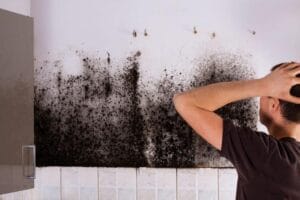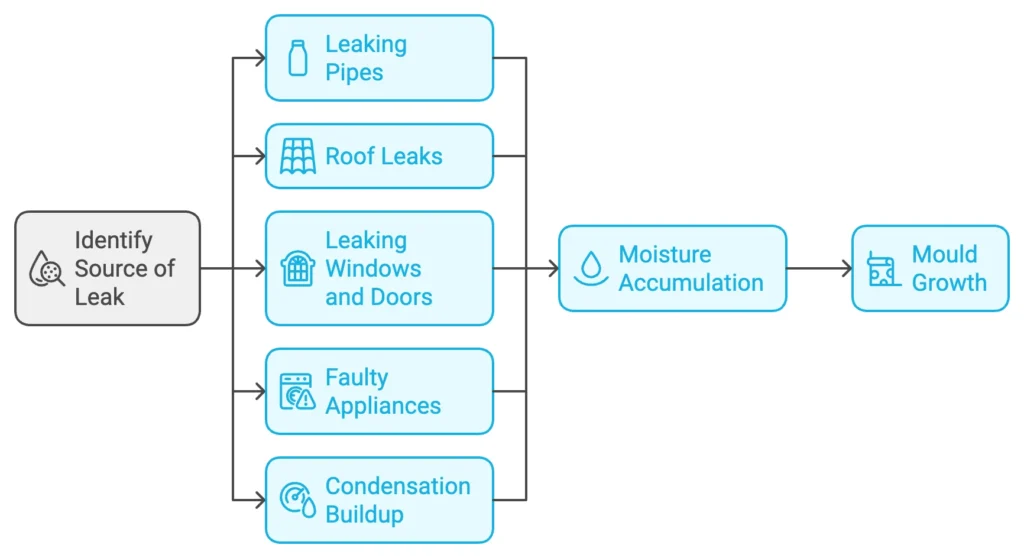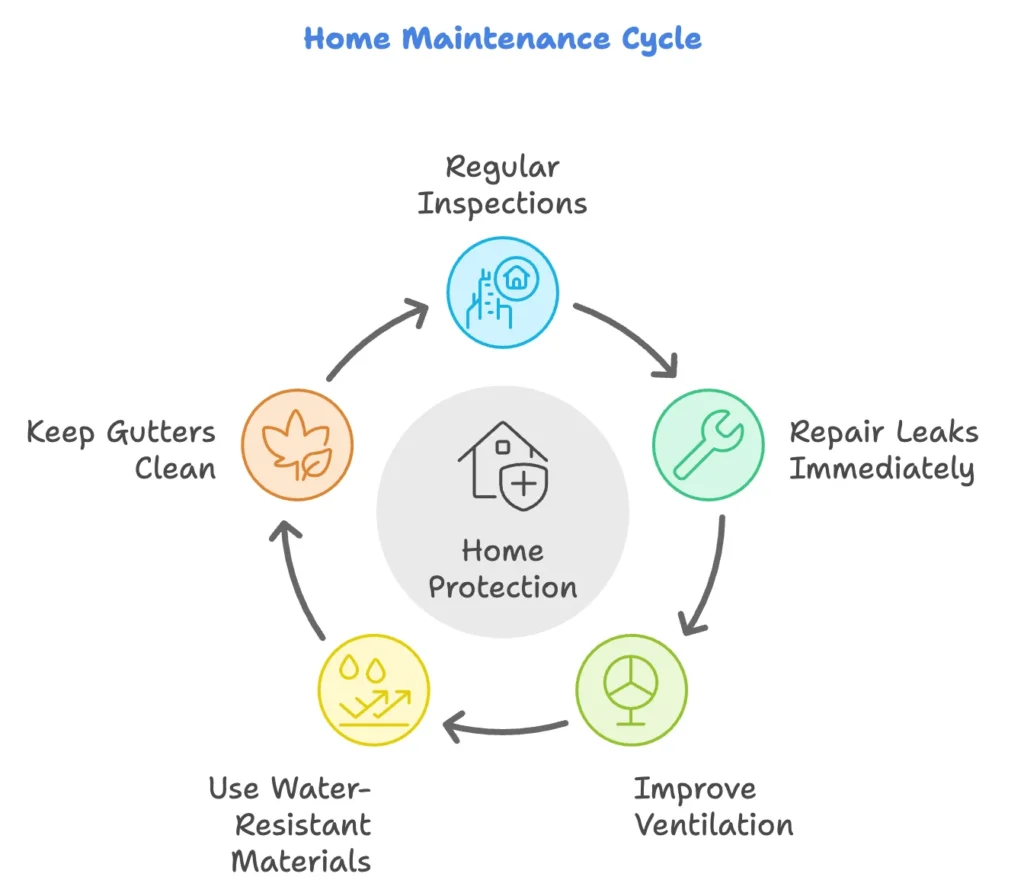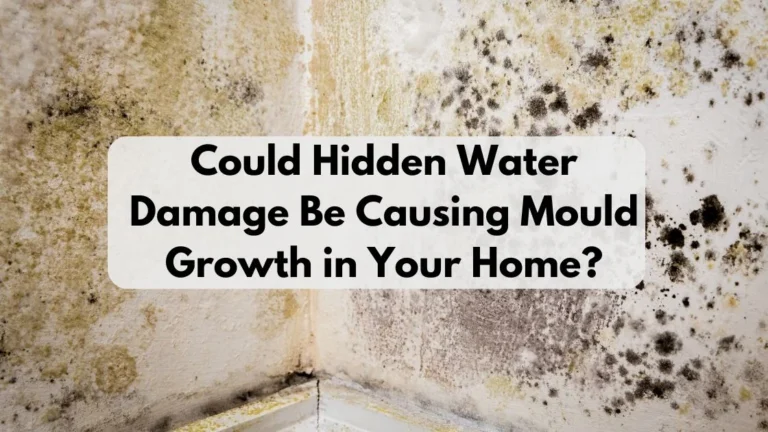Hidden water damage is often a silent culprit behind mould growth in homes, posing health risks and compromising indoor air quality. Identifying and addressing these hidden issues is crucial for maintaining a healthy living environment.
Mould growth can be an insidious problem in any home, often unnoticed until it becomes serious. One of the primary culprits behind this issue is hidden water damage—often from small leaks, condensation, or even poor ventilation.
This can create the ideal environment for mould to thrive, posing risks to both your health and your home’s structure. Let’s explore the causes of mould growth, the hidden water leaks that can trigger it, and the damage it can cause. We’ll also touch on implications for home insurance claims.
In this article, we’ll explore the causes of mould, how water leaks can trigger it, and the potential damage it can cause to your home. We’ll also discuss the implications for home insurance claims and whether or not an insurance policy would pay to repair any damage.
What Is Mould and How Does It Form?
Mould is a type of fungus that thrives in damp and humid conditions. It reproduces by releasing tiny spores into the air, which can land on various surfaces and begin to grow if the conditions are favourable.

While mould plays an essential role in nature by breaking down dead organic matter, it becomes a significant problem when it takes hold indoors.
There are many different types of mould, but the ones most commonly found in homes include:
- Cladosporium: Found on wood, textiles, and damp surfaces.
- Penicillium: Often found on decaying materials, including insulation and carpet.
- Aspergillus: Grows in damp environments and can be found on walls, ceilings, and floors.
- Stachybotrys chartarum: Commonly known as black mould, this toxic mould thrives in wet environments and can pose serious health risks.
How Mould Forms in Homes
Mould needs moisture to grow. When water or humidity is present in a home, whether from a visible source like a leaky roof or a hidden source like a dripping pipe behind the walls, it can create the ideal environment for mould. Mould spores are always present in the air, but they require damp surfaces to grow. The key factors contributing to mould growth include:
- Moisture: This is the single most important factor. It can come from leaks, condensation, or high humidity levels.
- Warmth: Mould grows best in warm conditions, though some types can grow in cooler environments.
- Lack of ventilation: Stagnant air in poorly ventilated areas like attics, basements, or behind furniture can increase the likelihood of mould growth.
How Water Leaks Can Lead to Mould Growth
One of the primary causes of mould growth is water leaks. While a small leak might seem insignificant, over time, it can lead to significant problems if not addressed. A leaky pipe behind a wall, for instance, can slowly release water into areas that are not immediately visible, such as wall cavities, floorboards, or under carpets. These damp areas are perfect breeding grounds for mould.
Types of Water Leaks That Cause Mould Growth

Various types of leaks can cause moisture to accumulate in areas where it shouldn’t, leading to mould growth. These include:
- Leaking Pipes Pipes, especially in older homes, are prone to wear and tear. A small crack or loose fitting can allow water to escape, leading to slow but continuous leakage. Pipes hidden within walls, floors, or ceilings are particularly problematic because the damage may not be immediately obvious. Over time, the moisture builds up and creates a conducive environment for mould.
- Roof Leaks: A roof leak might start with a missing tile or a small crack in the roofing material. However, even a minor breach can allow water to seep into the attic or the walls, promoting mould growth. The insulation in your attic is particularly vulnerable, as it can absorb moisture and take a long time to dry out, creating the perfect conditions for mould to grow.
- Leaking Windows and Doors: Poorly sealed windows and doors can allow rainwater to enter the house, especially during storms or heavy rainfall. Water can seep into the walls or floors surrounding the window or door frame, where it may not be immediately noticeable. This can lead to mould growth in areas that are rarely checked, such as behind curtains, blinds, or under floorboards.
- Faulty Appliances Household: appliances like washing machines, dishwashers, and water heaters are all potential sources of leaks. A small leak from these appliances can result in water pooling in areas that are hard to access or see. If left unchecked, this moisture can contribute to mould formation behind appliances, under flooring, or in walls.
- Condensation Buildup: In addition to leaks, condensation can also lead to mould growth. When warm, moist air comes into contact with cooler surfaces like windows, pipes, or walls, it can result in condensation. Over time, this can cause mould to develop on walls, ceilings, or even furniture.
Identifying Hidden Water Damage
Detecting water damage before it becomes a significant issue is key to preventing mould growth. While some signs of water leaks are obvious, such as dripping water or water stains, hidden water damage can be more challenging to identify. Here are some indicators to watch for:
- Musty smell: A persistent musty or damp smell can be a sign of hidden water damage.
- Peeling paint or wallpaper: Moisture behind walls can cause paint or wallpaper to bubble and peel.
- Discoloured patches: Yellow or brown stains on ceilings, walls, or floors often indicate water damage.
- Warped flooring: Moisture can cause wooden floors to warp or laminate to lift.
- Mould growth: Visible mould is a clear sign that water damage has already occurred.
If you notice any of these signs, it’s essential to investigate further to find the source of the water damage before mould takes hold.
The Consequences of Hidden Water Damage
Mould Damage
The most obvious consequence of hidden water damage is the rapid growth of mould. Once mould takes hold, it can quickly spread, affecting walls, floors, furniture, and even personal belongings. Removing mould can be time-consuming and costly, especially if the problem has been allowed to persist over an extended period.
Structural Damage
Water damage can weaken the structural integrity of your home. Persistent moisture can lead to rotting wood, crumbling plaster, and rusted metal components. In extreme cases, water damage can cause significant structural problems such as:
- Dry Rot: Dry rot is one of the most destructive consequences of long-term water exposure. It occurs when moisture promotes the growth of wood-decaying fungi, which consume the fibres that give wood its strength. Dry rot can spread through timber structures like beams, joists, and floorboards, leading to severe weakening of these elements. If left untreated, dry rot can cause parts of the home’s structure to collapse, resulting in costly repairs.
- Dampness and Wood Decay: Even if dry rot does not occur, damp wood will eventually deteriorate. The continual presence of moisture encourages wood decay, which, while not as fast-acting as dry rot, can still lead to significant damage. Floors may become spongy, doors may warp, and windows may stick, all due to dampness and wood decay.
- Damage to Plaster and Paint: Moisture from hidden leaks can damage plaster and paint, causing unsightly stains, bubbling, and peeling. Over time, the integrity of the plaster itself can be compromised, requiring extensive repairs to restore the appearance and functionality of the walls and ceilings.
Health Concerns
As mentioned earlier, mould poses significant health risks. Prolonged exposure to mould can lead to respiratory problems, allergies, and even more severe health conditions. Homes with hidden mould growth may become unsafe, particularly for individuals with pre-existing health conditions, the elderly, and young children.
The Role of Home Insurance in Water Damage and Mould Claims
If your home has suffered from water damage leading to mould, you may be wondering whether your insurance will cover the cost of repairs. Generally, home insurance policies cover sudden and accidental water damage, such as a burst pipe or a leaking roof caused by a storm. However, not all water damage is treated equally.
Water Damage Claims
Water damage claims are typically valid if the damage occurs suddenly and unexpectedly. For example, if a pipe bursts and floods your home, or a storm causes your roof to leak, your insurance will likely cover the repair costs and any resulting mould removal.
Exclusions and Denials
On the other hand, home insurance may not cover water damage that is the result of long-term neglect or maintenance issues. If mould has formed due to a slow leak that has been ongoing for months or years, insurance companies may argue that the damage could have been prevented with proper maintenance and inspections. In these cases, claims may be denied, leaving homeowners to cover the cost of repairs themselves.
It’s crucial to understand your policy’s terms and ensure that your home is properly maintained to prevent hidden water damage from becoming a costly problem.
How to Prevent Mould and Water Damage in Your Home

Preventing water damage and mould growth is far easier and less costly than dealing with the consequences after the fact. Here are some steps you can take to protect your home:
Regular Inspections
Regularly inspect your home for any signs of leaks, dampness, or mould. Check areas prone to moisture, such as under sinks, around windows, and in attics or basements.
Repair Leaks Immediately
If you discover a leak, no matter how small, repair it as soon as possible. Delaying repairs can lead to more severe problems down the line.
Improve Ventilation
Proper ventilation is key to preventing moisture buildup. Ensure that your home is well-ventilated, especially in high-moisture areas like kitchens, bathrooms, and basements. Use exhaust fans or dehumidifiers to reduce humidity levels.
Use Water-Resistant Materials
In areas of your home that are prone to moisture, such as bathrooms or kitchens, consider using water-resistant materials like tiles, water-resistant paint, or treated wood. These materials are less likely to absorb moisture and foster mould growth.
Keep Gutters Clean
Regularly clean your gutters and downspouts to prevent water from overflowing and causing water damage to your roof, walls, or foundation.
Conclusion
Hidden water damage can lead to mould growth, structural damage, and health risks if left untreated. Leaking pipes, roof leaks, and condensation are common causes of water damage that often go unnoticed.
By understanding the signs of water damage and taking steps to prevent leaks and dampness in your home, you can protect your property from the damaging effects of mould and avoid the costly repairs that come with it.
How PCLA Can Help You
PCLA are experts in handling insurance claims on behalf of policyholders. When hidden water damage and subsequent mould growth create a complex situation, PCLA can step in to help you navigate the often-daunting claims process.
Our experience ensures that your claim is presented effectively, maximising the likelihood of a fair settlement to cover the damage and necessary repairs.
As loss assessors, PCLA works exclusively for you, not the insurance company. This means we have your best interests at heart, providing guidance, managing paperwork, and negotiating with insurers to ensure you receive the settlement you’re entitled to.
Whether it’s evaluating the full extent of hidden water damage or making sure all aspects of your claim are addressed, PCLA can provide the support needed to help you restore your home efficiently and with minimal stress.



